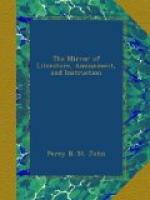* * * * *
THE SELECTOR AND LITERARY NOTICES OF NEW WORKS
* * * * *
TIMBER TREES.
In the last volume of the MIRROR, we gave several extracts from a delightful paper on Landscape Gardening, contained in a recent Number of the Quarterly Review; with an abstract of Sir Henry Steuart’s new method of transplanting trees, and a variety of information on this interesting department of rural economy. We are therefore pleased to see that the Society for the diffusion of Useful Knowledge, have appropriated the second part of their new work to what are termed “Timber Trees and their applications;” and probably few of their announced volumes will exceed in usefulness and entertainment that which is now before us. Indeed, the Editor could scarcely have devised a more successful means of impressing his readers with a sincere love of nature and her sublime works, than by introducing them to the history of vegetable substances in their connexion with the useful arts.
We subjoin a few specimens, with occasional notes, arising from our own reading and personal observation.
Picturesque Beauty of the Oak.
A fine oak is one of the most picturesque of Trees. It conveys to the mind associations of strength and duration, which are very impressive. The oak stands up against the blast, and does not take, like other trees, a twisted form from the action of the winds. Except the cedar of Lebanon, no tree is so remarkable for the stoutness of its limbs: they do not exactly spring from the trunk, but divide from it; and thus it is sometimes difficult to know which is stem and which is branch. The twisted branches of the oak, too, add greatly to its beauty; and the horizontal direction of its boughs, spreading over a large surface, completes the idea of its sovereignty over all the trees of the forest. Even a decayed oak,—
“------dry and dead, Still clad with reliques of its trophies old, Lifting to heaven its aged hoary head, Whose foot on earth Hath got but feeble hold—”
—even such a tree as Spenser has thus described is strikingly beautiful: decay in this case looks pleasing. To such an oak Lucan compared Pompey in his declining state.
The Cedar.
The cedar of Lebanon, though it has been introduced into many parts of England as an ornamental tree, and has thriven well, has not yet been planted in great numbers for the sake of its timber. No doubt it is more difficult to rear, and requires a far richer soil than the pine and the larch; but the principal objection to it has been the supposed slowness of its growth, although that does not appear to be very much greater than in the oak. Some cedars, which have been planted in a soil well adapted to them, at Lord Carnarvon’s, at Highclere, have grown




